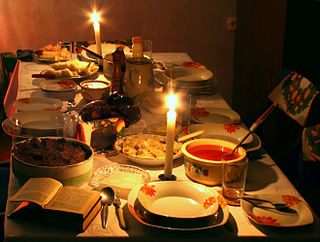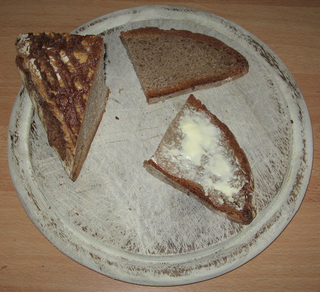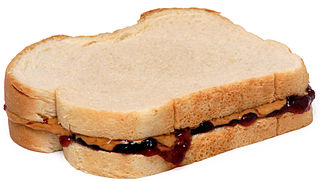Related Research Articles

A sandwich is a food typically consisting of vegetables, sliced cheese or meat, placed on or between slices of bread, or more generally any dish wherein bread serves as a container or wrapper for another food type. The sandwich began as a portable, convenient finger food in the Western world, though over time it has become prevalent worldwide.

Hungarian or Magyar cuisine is the cuisine characteristic of the nation of Hungary and its primary ethnic group, the Magyars. Traditional Hungarian dishes are primarily based on meats, seasonal vegetables, fruits, bread, and dairy products.

A scone is a baked good, usually made of either wheat or oatmeal with baking powder as a leavening agent, and baked on sheet pans. A scone is often slightly sweetened and occasionally glazed with egg wash. The scone is a basic component of the cream tea. It differs from teacakes and other types of sweets that are made with yeast. Scones were chosen as the Republic of Ireland representative for Café Europe during the Austrian Presidency of the European Union in 2006, while the United Kingdom chose shortbread.

A biscuit is a flour-based baked and shaped food product. In most countries biscuits are typically hard, flat, and unleavened. They are usually sweet and may be made with sugar, chocolate, icing, jam, ginger, or cinnamon. They can also be savoury, similar to crackers. Types of biscuit include sandwich biscuits, digestive biscuits, ginger biscuits, shortbread biscuits, chocolate chip cookies, chocolate-coated marshmallow treats, Anzac biscuits, biscotti, and speculaas.

A zeppola is an Italian pastry consisting of a deep-fried dough ball of varying size but typically about 4 inches (10 cm) in diameter. This fritter is usually topped with powdered sugar, and may be filled with custard, jelly, cannoli-style pastry cream, or a butter-and-honey mixture. The consistency ranges from light and puffy, to bread- or pasta-like. It is eaten to celebrate Saint Joseph's Day, which is a Catholic feast day.

A ploughman's lunch is an English cold meal based around bread, cheese, and fresh or pickled onions. Additional items can be added such as ham, green salad, hard boiled eggs, and apple, and usual accompaniments are butter and "pickle", which in Britain denotes a chutney-like condiment. As its name suggests, it is most commonly eaten at lunchtime. It is particularly associated with pubs, and often served with beer.

Mary and Eliza Chulkhurst, commonly known as the Biddenden Maids (1100–1134), were a pair of conjoined twins supposedly born in Biddenden, Kent, England, in the year 1100. They are said to have been joined at both the shoulder and the hip, and to have lived for 34 years. It is claimed that on their death they bequeathed five plots of land to the village, known as the Bread and Cheese Lands. The income from these lands was used to pay for an annual dole of food and drink to the poor every Easter. Since at least 1775, the dole has included Biddenden cakes, hard biscuits imprinted with an image of two conjoined women.

Rationing was introduced temporarily by the British government several times during the 20th century, during and immediately after a war.

Wigilia is the traditional Christmas Eve vigil supper in Poland, held on December 24. The term is often applied to the whole of Christmas Eve, extending further to Pasterka—midnight Mass, held in Roman Catholic churches all over Poland and in Polish communities worldwide at or before midnight. The custom is sometimes referred to as "wieczerza" or "wieczerza wigilijna", in Old Polish meaning evening repast, linked to the late church service, Vespers from the Latin.

A cheese sandwich is a sandwich made with cheese on bread. Typically semi-hard cheeses are used for the filling, such as Cheddar, Red Leicester, or Double Gloucester. A Guardian article called the cheese sandwich a "British lunchtime staple". Using a sandwich toaster or frying pan can transform the cheese sandwich into a cheese toastie.
Calennig is a Welsh word meaning "New Year celebration/gift", although it literally translates to "the first day of the month", deriving from the Latin word kalends. The English word "Calendar" also has its root in this word.
Ohsweken is a dispersed rural community located within the Six Nations of the Grand River, in the County of Brant, Ontario, Canada. Approximately 300 of the 2,700 homes on the reserve are in Ohsweken, and it is the site of the reserve governmental and administrative offices.

The German word Butterbrot describes a slice of bread topped with butter. The slice of bread could be served with cheese, sweet toppings or a slice of sausage and it is still called Butterbrot. The words in formal and colloquial German and the different dialects for butterbrot, simply Brot ("bread"), Butterstulle, Stulle, Schnitte, Botteramm, Bütterken to Bemme or Knifte (Ruhrdeutsch). Although it is increasingly replaced by other foods, it remains a common staple food in Germany. Since 1999, the last Friday in the month of September was made the Day of German Butterbrot by the Marketing Organization of German Agricultural Industries. Russian adopted the term buterbrod from New High German (Butterbrot), perhaps as early as the 17th century during the reign of Peter the Great. In modern Russian the term has a more general meaning, whatever the ingredient on top of the slice of bread is. From Russian, the term buterbrod was adopted into Azerbaijani, Belarusian, Georgian, Kazakh, Ukrainian, and Lithuanian.

The Carniolan sausage is a Slovenian sausage similar to what is known as kielbasa or Polish sausage in North America.

The ham sandwich is a common type of sandwich. The bread may be fresh or toasted, and it can be made with a variety of toppings including cheese and vegetables like lettuce, tomato, onion or pickle slices. Various kinds of mustard and mayonnaise are also common.

Cheese on toast is made by placing sliced or grated cheese on toasted bread and melting it under a grill. It is popular in the United Kingdom, Ireland, Australia and New Zealand, the Caribbean and in African countries.

A peanut butter and jelly sandwich (PB&J) consists of peanut butter and fruit preserves—jelly—spread on bread. The sandwich may be open-faced, made of a single slice of bread folded over, or made using two slices of bread. The sandwich is popular in the United States, especially among children; a 2002 survey showed the average American will eat 1,500 peanut butter and jelly sandwiches before graduating from high school. There are many variations of the sandwich, starting with the basic peanut butter sandwich or jam sandwich.
Bread and Cheese Creek is a tributary of the Back River in Baltimore County, Maryland. The creek is 3.2 miles (5.1 km) long, with headwaters just east of the Baltimore city line. It flows east through Baltimore County before emptying into the Back River, which flows into the Chesapeake Bay. The watershed area of the creek is 1.85 square miles (4.8 km2).
Bread and Cheese may refer to:
References
- ↑ "Thousands share Victoria Day bread, cheese on Six Nations", Sault Star , Sault Ste. Marie, Ontario, 2008. BROKEN LINK
- ↑ Maracle, Brian. Back on the Rez: Finding the Way Home. Penguin, 1997, p. 212.